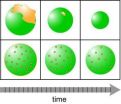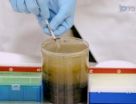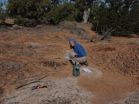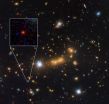(Press-News.org) Lawrence Livermore National Laboratory researchers are making key contributions to a physics experiment that will look for one of nature's most elusive particles, "dark matter," using a tank nearly a mile underground beneath the Black Hills of South Dakota.
The Large Underground Xenon (LUX) experiment located at the Sanford Underground Research Facility in Lead, S.D. is the most sensitive detector of its kind to look for dark matter. Thought to comprise more than 80 percent of the mass of the universe, scientists believe dark matter could hold the key to answering some of the most challenging questions facing physicists in the 21st century. So far, however, dark matter has eluded direct detection.
LLNL researchers have been involved in the LUX experiment since 2008.
"We at LLNL initially got involved in LUX because of the natural technological overlap with our own nonproliferation detector development programs," said Adam Bernstein, who leads the Advanced Detectors Group in LLNL's Physics Division.
"It's very exciting to reflect that as a result, we are now part of a world-class team that stands an excellent chance of being the first to directly and unambiguously measure cosmological dark matter particle interactions in an earthly detector."
The cutting-edge science and technology of rare event detection represented by LUX is of direct interest for LLNL and U.S. nonproliferation, arms control and nuclear security missions, Bernstein noted.
In particular, cryogenic noble liquid detectors of this kind may allow for improved, smaller footprint reactor antineutrino monitoring systems, with application to the International Atomic Energy Agency reactor safeguards regime.
Xenon and argon detectors of very similar design also have excellent neutron and gamma ray detection and discrimination properties, and may assist with missions related to the timely discovery and characterization of fissile materials in arms control and search contexts.
LLNL scientists and technicians have made important contributions to LUX.
Lab staff physicist Peter Sorensen has directed the LUX Analysis Working Group, spent months at the site helping to install the detector, and has written numerous peer-reviewed articles on how to perform searches for a range of dark matter candidates using LUX and related detectors.
Fellow LLNL staff physicist Kareem Kazkaz is the author of the LUX detector simulation package, known as LUXSIM, and has directed the Simulations Working Group for the project. The simulation software embodied in LUXSIM is uniquely well suited for low background detectors of this kind, and has been picked up by other users in the dark matter and nonproliferation communities.
LLNL technicians John Bower and Dennis Carr (who is now retired) both played key roles in the manufacture and installation of elements of the LUX detector, including building the precision-machined copper photo multiplier tube mounting apparatus. Lab safety engineer Gerry Mok performed detailed calculations demonstrating the safety of the LUX pressurized and cryogenic systems under a range of possible accident scenarios. His work was important to the successful safety review of the LUX detector.
The Sanford Underground Research Facility (Sanford Lab), located in the former Homestake gold mine, is owned and operated by the South Dakota Science and Technology Authority, with support from the Department of Energy and the DOE's Lawrence Berkeley National Laboratory. The LUX scientific collaboration includes dozens of scientists at 17 research universities and national laboratories in the United States and Europe.
The LUX detector took more than three years to build in a surface facility at the Sanford Lab. In July, a team of researchers, engineers and technicians installed the detector in an excavated cavern 4,850 feet underground. Nearly a mile of solid rock will protect the sensitive experiment from the shower of cosmic radiation that constantly bombards the surface of the earth. Cosmic radiation would drown out faint dark matter signals if the detector were on the surface.
LUX also must be protected from the small amounts of natural radiation from the surrounding rock. That's why the detector, which would just fit inside a telephone booth, was lowered into a very large stainless steel tank -- 20 feet tall by 24 feet in diameter. That tank has now been filled with more than 70,000 gallons of ultra-pure de-ionized water that will shield the detector from gamma radiation and stray neutrons.
###
For more information about the Sanford Lab, go to www.sanfordlab.org
Founded in 1952, Lawrence Livermore National Laboratory provides solutions to our nation's most important national security challenges through innovative science, engineering and technology. Lawrence Livermore National Laboratory is managed by Lawrence Livermore National Security, LLC for the U.S. Department of Energy's National Nuclear Security Administration.
LLNL scientists assist in building detector to search for elusive dark matter material
2012-11-16
ELSE PRESS RELEASES FROM THIS DATE:
Study: Cellphone bans associated with fewer urban accidents
2012-11-16
CHAMPAIGN, Ill. — Cellphones and driving go together like knives and juggling. But when cellphone use is banned, are drivers any safer?
It depends on where you're driving, a study by University of Illinois researchers says.
The study found that, long-term, enacting a cellphone ban was associated with a relative decrease in the accident rate in urban areas. However, in very rural areas, cellphone bans were associated with higher accident rates than would otherwise be expected.
"The main idea is to use the eye test when it comes to cellphone use," says study leader ...
Airborne particles smuggle pollutants to far reaches of globe
2012-11-16
RICHLAND, Wash. -- Pollution from fossil fuel burning and forest fires reaches all the way to the Arctic, even though it should decay long before it travels that far. Now, lab research can explain how pollution makes its lofty journey: rather than ride on the surface of airborne particles, pollutants snuggle inside, protected from the elements on the way. The results will help scientists improve atmospheric air-quality and pollution transport models.
The results also show that the particles that envelop pollutants also benefit from this arrangement. The new study in Environmental ...
Simplifying heart surgery with stretchable electronics devices
2012-11-16
Researchers at the McCormick School of Engineering are part of a team that has used stretchable electronics to create a multipurpose medical catheter that can both monitor heart functions and perform corrections on heart tissue during surgery.
The device marks the first time stretchable electronics have been applied to a surgical process known as cardiac ablation, a milestone that could lead to simpler surgeries for arrhythmia and other heart conditions. The researchers had previously demonstrated the concept to apply stretchable electronics to heart surgery, but with ...
Medical vital-sign monitoring reduced to the size of a postage stamp
2012-11-16
CORVALLIS, Ore. – Electrical engineers at Oregon State University have developed new technology to monitor medical vital signs, with sophisticated sensors so small and cheap they could fit onto a bandage, be manufactured in high volumes and cost less than a quarter.
A patent is being processed for the monitoring system and it's now ready for clinical trials, researchers say. When commercialized, it could be used as a disposable electronic sensor, with many potential applications due to its powerful performance, small size, and low cost.
Heart monitoring is one obvious ...
Video-article shows how to purify magnetic bacteria
2012-11-16
Magnetotactic bacteria, like Magnetospirillum magneticum, have evolved cellular processes that allow them to take up iron molecules to produce magnetic nanocrystals like magnetite. Since they were first discovered and isolated in 1975 by Robert Blakemore, scientists continue to be fascinated by these unique bacteria, whether as a means to isolate biogenic magnetite or to understand the evolutionary advantages of producing these minerals. A new video-article in JoVE (Journal of Visualized Experiments) details a procedure to purify and enrich samples of magnetotactic bacteria ...
Researchers report potential new treatment to stop Alzheimer's disease
2012-11-16
Last March, researchers at UCLA reported the development of a molecular compound called CLR01 that prevented toxic proteins associated with Parkinson's disease from binding together and killing the brain's neurons.
Building on those findings, they have now turned their attention to Alzheimer's disease, which is thought to be caused by a similar toxic aggregation or clumping, but with different proteins, especially amyloid-beta and tau.
And what they've found is encouraging. Using the same compound, which they've dubbed a "molecular tweezer," in a living mouse model ...
WSU scientists find new way for antibiotic resistance to spread
2012-11-16
PULLMAN, Wash.—Washington State University researchers have found an unlikely recipe for antibiotic resistant bacteria: Mix cow dung and soil, and add urine infused with metabolized antibiotic. The urine will kill off normal E. coli in the dung-soil mixture. But antibiotic-resistant E. coli will survive in the soil to recolonize in a cow's gut through pasture, forage or bedding.
"I was surprised at how well this works, but it was not a surprise that it could be happening," says Doug Call, a molecular epidemiologist in WSU's Paul G. Allen School for Global Animal Health. ...
Young gamers offer insight to teaching new physicians robotic surgery
2012-11-16
What can high school and college-age video game enthusiasts teach young surgeons-in-training?
According to a new study from researchers at the University of Texas Medical Branch at Galveston (UTMB) – a world leader in minimally invasive and robotic surgery – the superior hand-eye coordination and hand skills gained from hours of repetitive joystick maneuvers mimic the abilities needed to perform today's most technologically-advanced robotic surgeries.
To offer insight on how best to train future surgeons, the study placed high school and college students head to head ...
Degraded military lands to get ecological boost from CU-led effort
2012-11-16
Some arid lands in the American West degraded by military exercises that date back to General George Patton's Word War II maneuvers in the Mojave Desert should get a boost from an innovative research project led by the University of Colorado Boulder.
Headed up by CU-Boulder Assistant Professor Nichole Barger, the research team is focused on developing methods to restore biological soil crusts -- microbial communities primarily concentrated on soil surfaces critical to decreasing erosion and increasing water retention and soil fertility. Such biological soil crusts, known ...
Hubble helps find candidate for most distant object in the universe yet observed
2012-11-16
By combining the power of the NASA/ESA Hubble Space Telescope, NASA's Spitzer Space Telescope and one of nature's zoom lenses, astronomers have found what is probably the most distant galaxy yet seen in the Universe. The object offers a peek back into a time when the Universe was only 3 percent of its present age of 13.7 billion years.
We see the newly discovered galaxy, named MACS0647-JD, as it was 420 million years after the Big Bang. Its light has travelled for 13.3 billion years to reach Earth, which corresponds to a redshift of approximately 11 [1].
This is the ...



